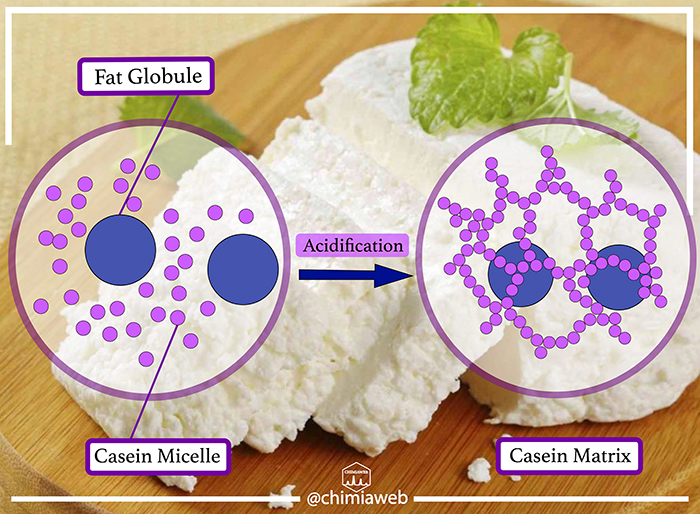Cheese is one of the favorite foods all over the world. Since milk is a perishable food, the shelf-life of milk can be extended by producing cheese. Now let us learn about the chemistry of cheese-making! Cheese-making involves the conversion of liquid milk into a semisolid and concentrated product by using a coagulation agent. Coagulation occurs through a chemical reaction, in which proteins accumulate and clump together.
The four major components of milk are protein, fat globules, lactose and minerals. In the process of cheese-making, casein micelles, the major protein of milk, coagulate to form solid curds. Fat globules and minerals are also trapped in the developing curd.
Coagulation process is triggered by three methods:
Enzyme Action
The enzyme used for milk coagulation is known as rennet. There are several types of rennet. Traditionally, animal rennet is used in the preparation of all types of cheese. It is isolated from ruminant (calf, kid, or lamb) stomach. The major component of rennet is chymosin. In addition to chymosin, it also contains some pepsin. Some believe that animal rennet yields more pleasant flavor for cheese.
Rennets with bacterial and plant origin are used as a substitute for animal rennet. However, they may give rise to a bitter and undesirable flavor to the cheese.
As another alternative, genetically engineered microorganisms are employed to produce chymosin. Since these microorganisms function through fermentation, the generated enzyme is called fermentation-produced chymosin.
Acid Addition
Milk for cheese-making may be acidified by lactic acid bacteria. Lactic acid bacteria function as starter culture. They acidify milk by producing lactic acid. They can transform lactose (milk sugar) into lactic acid through fermentation. When the acidity of milk increases, milk proteins start to stick together.
Acid and Heat Addition
Acid-heat coagulation is used for the production of several cheeses. The function of acid is discussed above. Heat treatment denatures whey, the other main type of milk protein. The unraveled whey proteins bond to each other, or to casein proteins. It is followed by the contribution of acid for coagulation.
When the coagulation process is complete, the curd, which is the solid part, is separated. Then salt is added for flavor, which also acts as a preservative. Cheese is formed into its specific shape and left to ripen.

